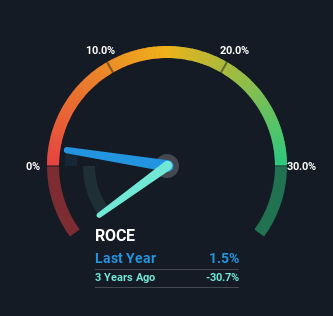Returns Are Gaining Momentum At Dynasty Fine Wines Group (HKG:828)

To find a multi-bagger stock, what are the underlying trends we should look for in a business? Ideally, a business will show two trends; firstly a growing return on capital employed (ROCE) and secondly, an increasing amount of capital employed. Ultimately, this demonstrates that it's a business that is reinvesting profits at increasing rates of return. So on that note, Dynasty Fine Wines Group (HKG:828) looks quite promising in regards to its trends of return on capital.
What Is Return On Capital Employed (ROCE)?
For those who don't know, ROCE is a measure of a company's yearly pre-tax profit (its return), relative to the capital employed in the business. Analysts use this formula to calculate it for Dynasty Fine Wines Group:
Return on Capital Employed = Earnings Before Interest and Tax (EBIT) ÷ (Total Assets - Current Liabilities)
0.015 = HK$3.7m ÷ (HK$475m - HK$227m) (Based on the trailing twelve months to June 2023).
Thus, Dynasty Fine Wines Group has an ROCE of 1.5%. Ultimately, that's a low return and it under-performs the Beverage industry average of 12%.
See our latest analysis for Dynasty Fine Wines Group

Historical performance is a great place to start when researching a stock so above you can see the gauge for Dynasty Fine Wines Group's ROCE against it's prior returns. If you're interested in investigating Dynasty Fine Wines Group's past further, check out this free graph of past earnings, revenue and cash flow.
What Does the ROCE Trend For Dynasty Fine Wines Group Tell Us?
Dynasty Fine Wines Group has broken into the black (profitability) and we're sure it's a sight for sore eyes. While the business was unprofitable in the past, it's now turned things around and is earning 1.5% on its capital. Interestingly, the capital employed by the business has remained relatively flat, so these higher returns are either from prior investments paying off or increased efficiencies. So while we're happy that the business is more efficient, just keep in mind that could mean that going forward the business is lacking areas to invest internally for growth. So if you're looking for high growth, you'll want to see a business's capital employed also increasing.
One more thing to note, Dynasty Fine Wines Group has decreased current liabilities to 48% of total assets over this period, which effectively reduces the amount of funding from suppliers or short-term creditors. Therefore we can rest assured that the growth in ROCE is a result of the business' fundamental improvements, rather than a cooking class featuring this company's books. Nevertheless, there are some potential risks the company is bearing with current liabilities that high, so just keep that in mind.
The Key Takeaway
As discussed above, Dynasty Fine Wines Group appears to be getting more proficient at generating returns since capital employed has remained flat but earnings (before interest and tax) are up. Given the stock has declined 41% in the last three years, this could be a good investment if the valuation and other metrics are also appealing. So researching this company further and determining whether or not these trends will continue seems justified.
Since virtually every company faces some risks, it's worth knowing what they are, and we've spotted 5 warning signs for Dynasty Fine Wines Group (of which 2 are a bit unpleasant!) that you should know about.
For those who like to invest in solid companies, check out this free list of companies with solid balance sheets and high returns on equity.
New: Manage All Your Stock Portfolios in One Place
We've created the ultimate portfolio companion for stock investors, and it's free.
• Connect an unlimited number of Portfolios and see your total in one currency
• Be alerted to new Warning Signs or Risks via email or mobile
• Track the Fair Value of your stocks
Have feedback on this article? Concerned about the content? Get in touch with us directly. Alternatively, email editorial-team (at) simplywallst.com.
This article by Simply Wall St is general in nature. We provide commentary based on historical data and analyst forecasts only using an unbiased methodology and our articles are not intended to be financial advice. It does not constitute a recommendation to buy or sell any stock, and does not take account of your objectives, or your financial situation. We aim to bring you long-term focused analysis driven by fundamental data. Note that our analysis may not factor in the latest price-sensitive company announcements or qualitative material. Simply Wall St has no position in any stocks mentioned.
About SEHK:828
Dynasty Fine Wines Group
An investment holding company, produces and sells grape wine products in the People’s Republic of China.
Flawless balance sheet with proven track record.


